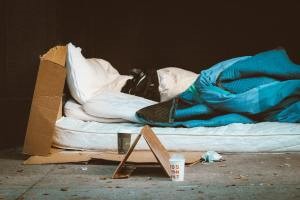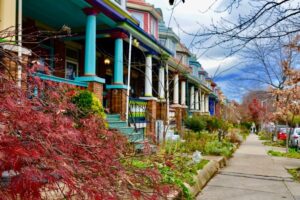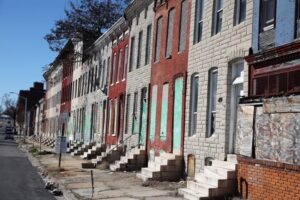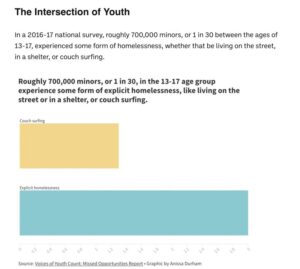
By Tashi McQueen,
AFRO Political Writer,
tmcqueen@afro.com
Take a five-mile drive through Baltimore and you can’t help but notice how wealth is disproportionately dispersed throughout the area. Though Charm City is home to the affluent communities of Charles Village, Harbor East, Canton and Gilford, it’s also home to more than 14,000 abandoned homes on hundreds of long-forgotten blocks.
The high-end neighborhoods quickly give way to homeless encampments sprawled across the D.C. area. Last year, the point-in-time count done by the Mayor’s Office of Homeless Services also found that on a random February night in Baltimore, more than 1,500 people were sleeping on the street.
Kindled by poverty and fanned into flames by economic inflation and COVID -19, homelessness is an American firestorm, and it burns brightly in Baltimore. A snapshot of that dilemma is now emerging, according to social researchers and anti-poverty advocates.
Nearly half of Baltimore’s residents live below 200 percent of the federal poverty line, according to information from Health Care for the Homeless (HCH) researchers, who found recently that more than half of the city’s poor live on annual incomes that are at or below 50 percent of the national poverty line. Data also shows that more than one-third of children in Baltimore City live in low-income households.
The current federal poverty level, as determined by the U.S. Department of Health and Human Services, is an income of $14,580 a year for an individual or $30,000 a year for a family of four.
HCH cited healthcare limitations as another contributing factor for Baltimore residents living on the poverty line. They found that insurance doesn’t cover 40 percent of the services their clients need.

Baltimore city government 2022 statistics say it is hard to track unaccompanied homeless youth, as it is not always prevalent, but they know at least 13 percent of homeless people are youth accompanied by a parent or guardian.
“Most youth who fall into homelessness are aging out of the foster care system,” said Lonnie Walker, founder of JOY Baltimore. “We also find the issue to be that some young people think they can do what they want in their parent’s home and it doesn’t work out.”
Black Baltimoreans are significantly disadvantaged.
According to a report by The Urban Institute, poverty entry rates are twice as high for Blacks as Whites— 11 percent versus 5 percent. Low-income individuals have a 30 percent chance of getting out of poverty annually, but Black people, households led by women and households with more children have a reduced ability to escape poverty.
“If you look at the neighborhoods that make up the Black butterfly, more than half the residents within the Butterfly have problems with blight,” said Nneka Nnamdi of Fight Blight. “Sixty percent of folks in Baltimore are housing insecure, which means people paid more than 30 percent of their income in housing costs. In a predominantly Black city, we know many Black people are affected by blight and housing insecurities.”

According to a Vacant Property Research Network report, housing blight is the presence of dilapidated buildings, vacant lots, and abandoned houses that bring down a neighborhood’s value and pose a safety risk for the community.
Aside from more than 14,000 abandoned and vacant buildings, there are another 21,000 vacant lots and 34,000 properties with notable risk of vacancy in Baltimore, according to Baltimoreans United In Leadership Development (BUILD).
BUILD is a multi-faith community organization working to improve Baltimorean quality of life.
An economic report from Maryland’s Department of Commerce reveals that Baltimore’s population continues to decrease; Baltimore has lost 34,830 residents since 2010.
A Fight Blight report says the steep decrease in residents has caused a dysfunctional real estate market and higher taxes than residents and businesses can afford.

“Blight is a driver of displacement and, in that regard, a driver of homelessness,” said Nnamdi. “If someone cannot safely live in an apartment, row home, single-family homes, often people are left to couch surf, house squat, go to homeless shelters or move somewhere afar off, leaving them disconnected.”
Due to this reality, several Baltimore Homeless organizations are working to curb the crisis.
“Baltimore Outreach Services is one of only three emergency shelter programs in the city that serves women and children. The families we serve are the poorest in Baltimore City and are a vulnerable population with few resources and many barriers to success,” said Cathy Wood-Rupert, executive director of Baltimore Outreach Services in a statement. “Located in the Inner Harbor area of Baltimore, the shelter houses up to 40 individuals 24/7, providing three meals per day. Baltimore Outreach also provides wrap-around services to aid residents in identifying housing opportunities, mental and physical health services, job placement services, children’s educational needs, financial literacy and nutritional programs.”
JOY Baltimore is a local organization that works to assist and build up Baltimore’s youth.
“JOY serves Black, Latino, White and immigrant people around Baltimore and the state of Maryland,” said Walker. “JOY has helped homeless youth in a nationwide challenge throughout the city. We had to house 100 young people in 100 days and succeeded. We helped 134 people ages 18-24.”
About 85 percent of the youth JOY Baltimore has helped are Black.
“We hold youth 12-24 accountable for what they need such as school, employment resources, food support, bus tokens,” continued Walker.
Anissa Durham from Word in Black contributed to this article.
Tashi McQueen is a Report For America Corps Member.
Similar articles:
Children-with-chronic-disability-deserve-affordable-quality-healthcare
Are-we-finally-getting-after-school-programs-right
Researchers-announce-plan-to-end-hiv-in-black-america
Top-5-memorable-black-educators-in-tv-and-film
nfl-has-been-slow-to-embrace-mental-health-support-for-players
—
most-americans-are-one-crisis-away-from-becoming-unhoused
411956-Transitioning-In-and-Out-of-Poverty.PDF
The post A tale of two cities: a look at Baltimore’s housing insecurity challenge appeared first on AFRO American Newspapers .
This article originally appeared in The Afro.










